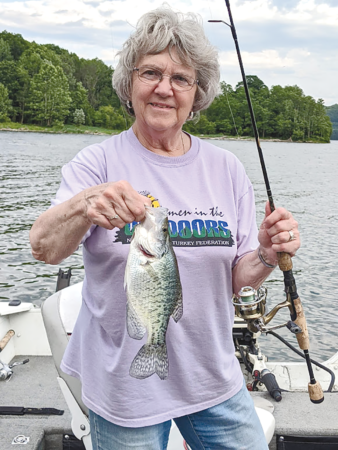I’ve had a few crappy fishing days over the years, but that’s seldom the case when I’m fishing for crappies. The truth is crappies can be taken year-round; we catch them through the ice in good numbers, and spring, summer, and fall can also be productive. The key is to know where to look for crappies at any given time of the year and to utilize suitable equipment and offerings.
Crappies are a part of a larger group of fish species often referred to as “panfish.” I believe the name panfish came from the fact that this group of fish easily fits into a frying pan to provide a tasty meal for several people. It’s very common for youngsters to get their start in fishing by going to a local pond to catch willing panfish, but oddly enough, I actually got my start in serious fishing by chasing trout on large streams.
It wasn’t long after I got into trout fishing, though, that I realized how much fun catching panfish could be. Even after I added panfish to my fishing agenda, it was a couple more years until I got serious about pursuing crappies, likely because where I lived at the time, there was no good crappie fishing water.
Not only is crappie fishing a lot of fun, but in addition, the fillets provide an excellent meal. Last week my wife and I enjoyed “living off the land,” eating crappie fillets rolled in eggs and cracker meal and fried in butter with the added bonus of a good batch of freshly picked morel mushrooms.
Of course, before you can enjoy eating a batch, you have to catch them first, and now is a good time to do just that.
In spring, crappies move from the deep water into shallower water in bays in search of warmer temperatures, food, and to spawn. You can even have a successful day of fishing if you don’t have access to a boat since fishing from the shore in a lot of places can put you within reach of feeding crappies. Of course, the crappies will eventually again return to deeper water as temperatures in the lake rise, and a boat makes the chances of success much greater.
Crappie fishing is often relatively easy and productive this time of year, and in fact, I rarely ever bother with any kind of bait. Probably one of the best presentations is a simple small one-sixteenth ounce or one-thirty-second once lead head jig with an inch and a half split-tail, soft plastic, or a small soft plastic grub. As far as color, I’ve had success with brown, white, yellow, black, and chartreuse, but chartreuse and white are usually at the top of the list.
When the crappies are in the shallower water, there are a couple of presentations that produce well. If I think I’m relatively safe while retrieving my lure, I will simply pitch my jig and grub and let it sink to my desired depth on a tight line before I start my erratic retrieve; the key is to keep a tight line to feel the strike-set the hook right away. If I’m concerned about hanging up on structure on or near the bottom, I will attach a very small bobber and pitch the presentation over stickups where the crappies may be holding. Even the slightest twitch of the bobber should elicit a hook set.
Crappies are often very willing to take your offering this time of year, and large numbers can sometimes be caught, so I suggest being frugal; ten decent-sized crappies provide a good meal for two people. Also, there are different regulations on different lakes, so make sure you know what the legal take is and the legal size before you keep any crappies.




